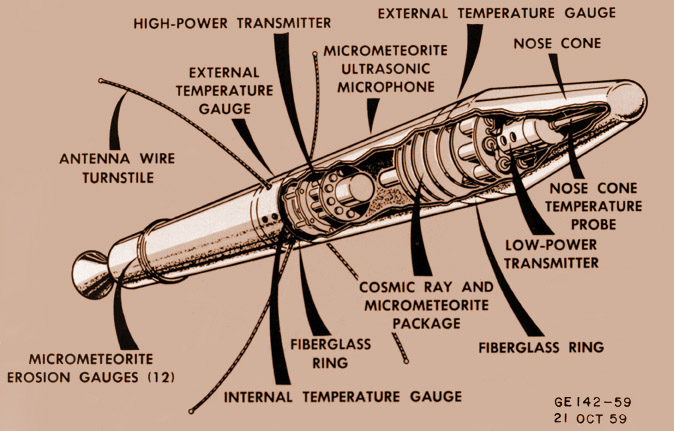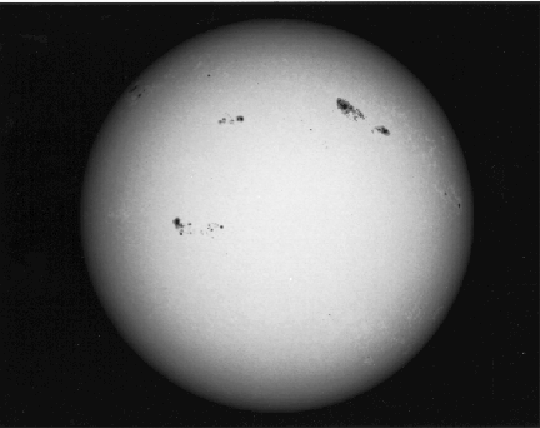
The Sun's environment

The outer solar atmosphere is a hot
plasma permeated by complicated magnetic fields which are
constantly changing. In contrast, the Earth's
magnetic field is fairly simple and changes only slowly with
time. A magnetic
compass placed in one of
the Earth's field loops points along the loop, toward magnetic
north.
Because the gas in the solar atmosphere is a plasma, it tends to move along magnetic field loops and finds it extremely difficult to move across the magnetic field. Here is a closeup view of field loops in the Sun's atmosphere:
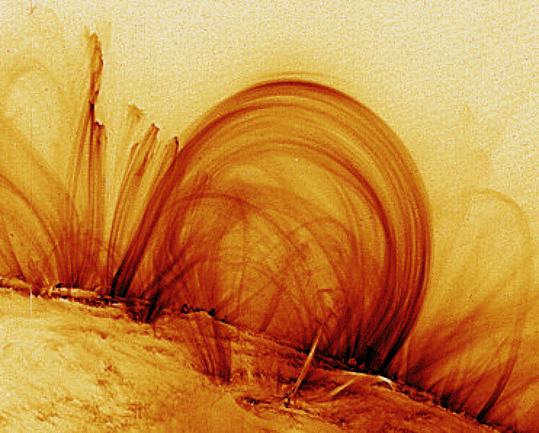
Viewed on a larger scale, there is
more order. The magnetic field is stretched out into the
radial direction (Note the
comet about to collide with the Sun.)
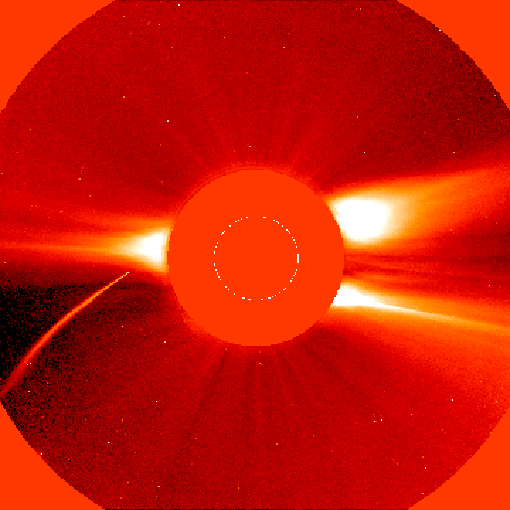
The space between planets is not empty! The Sun produces a huge bubble of plasma which flows into space from the Sun's extremely hot outer layer (the corona), and ultimately runs up against the interstellar gas that lies between stars. This bubble is called the heliosphere.
Here is a web site that describes
current conditions on the Sun and resulting effects on the
Earth:
http://www.sec.noaa.gov/SWN/
We are currently in a period of a fairly weak solar maximum and low probability of coronal mass ejections. But at all times, the corona is heated to temperatures of millions of degrees. Because of the high temperature, the gas in the corona forms a plasma. The high temperature is a result of heating from the photosphere below, and the inability of the very tenuous coronal gas to get rid of the heating very rapidly. The outermost layers of planets' atmospheres have analogous regions of high temperature.
The Sun cannot hold such
high-temperature plasma with its gravitational field, so the
plasma blows off into space in all directions, primarily
escaping from coronal holes. This escaping plasma is known as
the solar wind, and it fills all of space between the
planets out to the farthest distances that have been probed by
spacecraft. The wind is very gusty, and a blast of high-energy
plasma could be very dangerous to astronauts. The speed of the
solar wind is variable, but is typically about 450 km/s near the
ecliptic plane, and can be as high as 600 km/s at higher
latitudes.
The solar wind always flows radially outward from the Sun. It is modulated by the Sun's rotation -- it takes about a month for the Sun to rotate once. Outbreaks of plasma ejection on the Sun are followed about 4 days later by effects at the Earth as the plasma reaches the Earth.
The entire region of space that is filled by the escaping solar plasma is called the heliosphere. The four spacecraft that are on escape orbits from the solar system are: Pioneers 10 and 11, and Voyagers 1 and 2. Voyager 1 reached a major milestone on December 13, 2010 -- it no longer senses the solar wind, and so it is getting close to interstellar space and (according to the latest reports) may be there.The spacecraft Pioneer 10 and 11
probed the farthest reaches of the heliosphere during the 1980s,
1990s and early 21st century. But the power
source on Pioneer 10 finally degraded to the point where the
signal to Earth dropped below the threshold for detection in its
latest contact attempt on 7 February, 2003. Pioneer 10 will
continue to coast silently as a ghost ship through deep space
into interstellar space, heading generally for the red star
Aldebaran, which forms the eye of Taurus (The Bull). Aldebaran
is about 68 light years away and it will take Pioneer 10 over 2
million years to reach it.
The
Pioneer 11 Mission ended on 30 September 1995, when the last
transmission from the spacecraft was received. There have been
no communications with Pioneer 11 since. The Earth's motion
carried it out of the view of the spacecraft antenna. The
spacecraft cannot be maneuvered to point back at the Earth. It
is not known whether the spacecraft is still transmitting a
signal. No further tracks of Pioneer 11 are scheduled. The
spacecraft is headed toward the constellation of Aquila (The
Eagle), Northwest of the constellation of Sagittarius. Pioneer
11 will pass near one of the stars in the constellation in about
4 million years.
The two spacecraft Voyagers 1 and 2
are still alive (sort of) and are at the farthest boundaries of
the solar system, at 127 AU and 104 AU respectively. They
have been renamed Voyager
Interstellar Mission.
The two spacecraft are the most
distant human-made objects, out at the edge of the heliosphere,
the bubble the sun creates around the solar system. Mission
managers expect Voyager 1 to leave our solar system and enter
interstellar space soon, with Voyager 2 on track to enter
interstellar space shortly afterward. Voyager 1 is in good
health and performing normally; lately there have been some
glitches with Voyager 2.
Within the heliosphere are "bubbles" formed by the magnetospheres of planets. A magnetosphere is the region where plasma flow is dominated by a planet's magnetic field. Fact: Plasma cannot flow across magnetic field lines -- it always flows along magnetic field lines.
Here is a diagram of the Earth's magnetosphere (solar wind is coming from the left):R_magneto.html
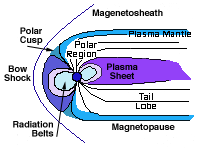
Solar wind plasma which is captured onto the Earth's magnetic field lines is accelerated to high energies, and deposits this energy in the region where the magnetic field lines enter the Earth's atmosphere near the north and south magnetic poles. This is called the auroral oval.
Close to the Earth's magnetic
equator, and starting about 400 km above the Earth's surface,
there are two belts of trapped high-energy plasma called the Van
Allen belts. The inner Van Allen belt poses a danger to
astronauts (and instruments) who are in spacecraft with orbits
that pass through this belt. The Van Allen belts were
discovered by instruments on the first US spacecraft, Explorers
1 and 3, in 1958.
Sketch
of the Van Allen belts:
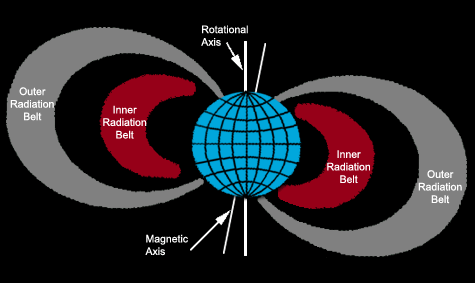
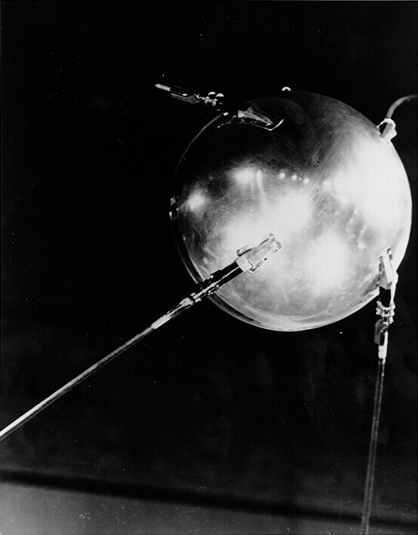
The mastermind of the Soviet space program, the man who designed the Semyorka and who is generally given credit for Sputnik-1 and a subsequent series of spectacular Russian space achievements that startled the USA, was Sergei Korolev (pronounced sur-gay koralyov):
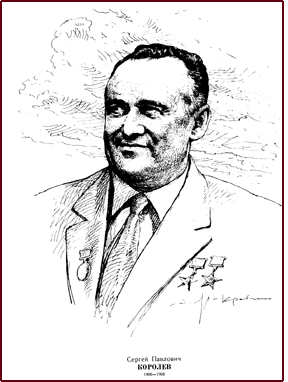
At the end of 1957, the US was
trying desperately to catch up with the Russians. Here is
a description from an official NASA history.
(Orders of
Magnitude: A History of the NACA and NASA, 1915-1990.
By Roger E.
Bilstein, University of Houston, Clear Lake.
Published as
NASA Special Publication-4406 in the NASA History Series,
1989)
"On 6 December 1957, the much-touted Vanguard test vehicle rose about 3 feet from the launch platform, shuddered, and collapsed in flames. Its tiny 3-pound payload broke away and lay at the edge of the inferno, beeping impotently."
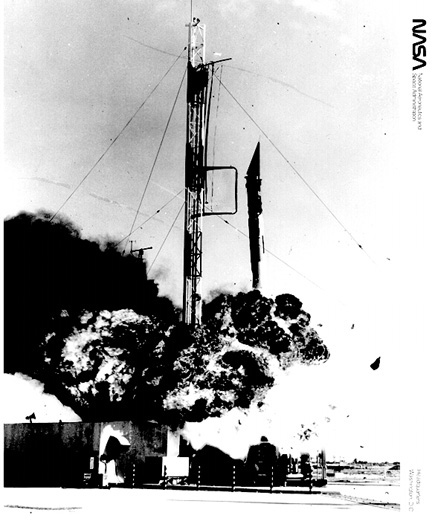
The next year, 1958, the Russians
orbited Sputnik-3, which carried scientific experiments,
including a Geiger counter to measure high-energy particles in
space. However, the tape recorder failed and they couldn't
get their data back properly.
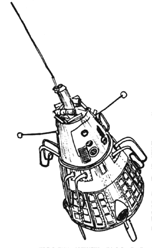
That same year, the US launched
Explorer-1 on a military Redstone
(Jupiter) rocket (click here for a side-by-side view of the Vanguard and the Jupiter-C
at the National Air and Space Museum [courtesy of Catherine
Neish]). This was the first US satellite, carrying James
Van Allen's Geiger counter experiment that made the historic
first space discovery.
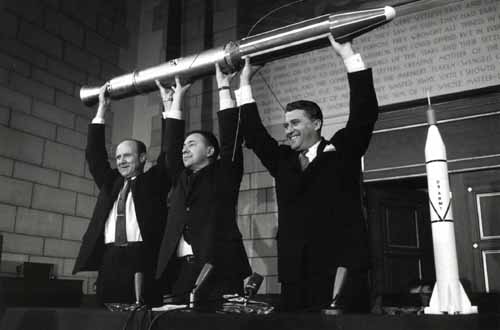
William
Pickering, James Van
Allen, and Wernher
von Braun
Again, from the official NASA
history:
"Clouds of gloom deepened into the
new year. Then, finally, a small rift. On 31 January 1958, an
American satellite at last went into orbit. Not Vanguard but the
ABMA-JPL Explorer had redeemed American honor. True, the payload
weighed only 2 pounds against the 1100 of Sputnik 2. But there
was a scientific first; an experiment aboard the satellite
reported mysterious saturation of its radiation counters at 594
miles altitude. Professor James A. Van Allen, the scientist who
had built the experiment, thought this suggested the existence
of a dense belt of radiation around the Earth at that altitude.
American confidence perked up again on 17 March when Vanguard 1
joined Explorer 1 in orbit."
Diagram of
Explorer 1, the first US satellite:
